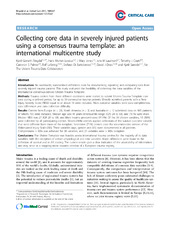| dc.contributor.author | Ringdal, Kjetil Gorseth | en_US |
| dc.contributor.author | Lossius, Hans Morten | en_US |
| dc.contributor.author | Jones, Mary J. | en_US |
| dc.contributor.author | Lauritsen, Jens M. | en_US |
| dc.contributor.author | Coats, Timothy J. | en_US |
| dc.contributor.author | Palmer, Cameron S. | en_US |
| dc.contributor.author | Lefering, Rolf | en_US |
| dc.contributor.author | Bartolomeo, Stefano Di | en_US |
| dc.contributor.author | Dries, David J. | en_US |
| dc.contributor.author | Søreide, Kjetil | en_US |
| dc.date.accessioned | 2012-01-24T11:31:40Z | |
| dc.date.available | 2012-01-24T11:31:40Z | |
| dc.date.issued | 2011-10-12 | eng |
| dc.Published | Critical Care 2011, 15:R237 | en |
| dc.identifier.issn | 1364-8535 | |
| dc.identifier.uri | https://hdl.handle.net/1956/5521 | |
| dc.description.abstract | Introduction: No worldwide, standardised definitions exist for documenting, reporting and comparing data from severely injured trauma patients. This study evaluated the feasibility of collecting the data variables of the international consensus-derived Utstein Trauma Template. Methods: Trauma centres from three different continents were invited to submit Utstein Trauma Template core data during a defined period, for up to 50 consecutive trauma patients. Directly admitted patients with a New Injury Severity Score (NISS) equal to or above 16 were included. Main outcome variables were data completeness, data differences and data collection difficulty. Results: Centres from Europe (n = 20), North America (n = 3) and Australia (n = 1) submitted data on 965 patients, of whom 783 were included. Median age was 41 years (interquartile range (IQR) 24 to 60), and 73.1% were male. Median NISS was 27 (IQR 20 to 38), and blunt trauma predominated (91.1%). Of the 36 Utstein variables, 13 (36%) were collected by all participating centres. Eleven (46%) centres applied definitions of the survival outcome variable that were different from those of the template. Seventeen (71%) centres used the recommended version of the Abbreviated Injury Scale (AIS). Three variables (age, gender and AIS) were documented in all patients. Completeness > 80% was achieved for 28 variables, and 20 variables were > 90% complete. Conclusions: The Utstein Template was feasible across international trauma centres for the majority of its data variables, with the exception of certain physiological and time variables. Major differences were found in the definition of survival and in AIS coding. The current results give a clear indication of the attainability of information and may serve as a stepping-stone towards creation of a European trauma registry. | en_US |
| dc.language.iso | eng | eng |
| dc.publisher | BioMed Central | eng |
| dc.rights | Attribution CC BY | eng |
| dc.rights.uri | http://creativecommons.org/licenses/by/2.0/ | eng |
| dc.title | Collecting core data in severely injured patients using a consensus trauma template: an international multicentre study | en_US |
| dc.type | Peer reviewed | |
| dc.type | Journal article | |
| dc.description.version | publishedVersion | en_US |
| dc.rights.holder | Copyright 2011 Ringdal et al.; licensee BioMed Central Ltd. | |
| dc.identifier.doi | https://doi.org/10.1186/cc10485 | |
| dc.identifier.cristin | 909711 | |
| dc.subject.nsi | VDP::Medical disciplines: 700::Health sciences: 800::Health service and health administration research: 806 | eng |

